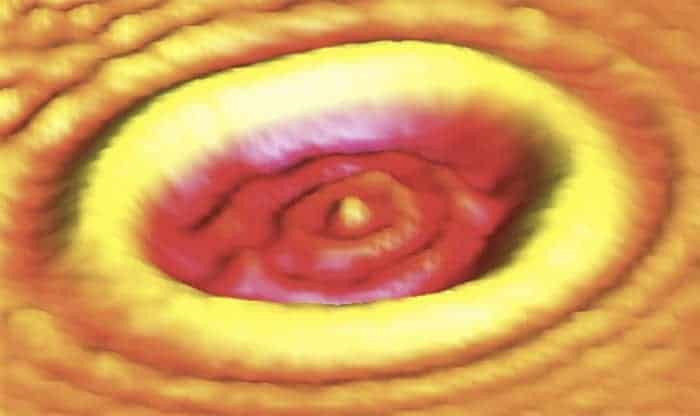Giant orbital magnetic moment appears in a graphene quantum dot
20 Apr 2023 Isabelle Dumé
In the lab: physicist Jairo Velasco Jr (left) and graduate student Zhehao Ge. Behind them is the scanning tunnelling microscope that they use to create and study graphene quantum dots. (Courtesy: Tianhui Zhu)
A giant orbital magnetic moment exists in graphene quantum dots, according to new work by physicists at the University of California Santa Cruz in the US. As well as being of fundamental interest for studying systems with relativistic electrons – that is those travelling at near-light speeds – the work could be important for quantum information science since these moments could encode information.
Graphene, a sheet of carbon just one atom thick, has a number of unique electronic properties, many of which arise from the fact that it is a semiconductor with a zero-energy gap between its valence and conduction bands. Near where the two bands meet, the relationship between the energy and momentum of charge carriers (electrons and holes) in the material is described by the Dirac equation and resembles that of a photon, which is massless.
These bands, called Dirac cones, enable the charge carriers to travel through graphene at extremely high, “ultra-relativistic” speeds approaching that of light. This extremely high mobility means that graphene-based electronic devices such as transistors could be faster than any that exist today.
When these electrons are confined in a graphene quantum dot, which is a nanoscale structure, they travel at high speeds in circular loops around the edge of these dots, thereby creating orbital magnetic moments. These moments have energies of up to around 70 meV/T and a value of around 600 Bohr magnetons (µB, a physical constant that expresses the magnetic moment of an electron created by its orbital or spin angular momentum).
Giant magnetic moments
In the new work, a team led by Jairo Velasco Jr built on a technique that Velasco and his previous colleagues pioneered in 2015. The researchers produced quantum dots with extremely sharp confinement potentials that trapped graphene electrons travelling near the edge of the nanoscale structure. They then measured the way that the states of these electrons responded to an externally applied magnetic field.
“This allowed us to discover that the states possess giant magnetic moments, a property that endows them with an acute sensitivity to magnetic fields,” says Velasco. “Our theory collaborators Sergey Slizovskiy and Vladimir Fal’ko pointed out that the giant magnetic moments of these states stem from their extreme speeds (near the speed of light).”
The moments’ sensitivity to external fields could allow them to be used as quantum sensors that can detect and therefore map these fields at the nanoscale with high resolution, say the researchers.READ MORE

“The fast electronic states that live at the edge of the graphene quantum dot can also be thought of as a persistent current – that is, one that does not require an external source to circulate,” Velasco tells Physics World. “Such systems have been studied previously in metallic rings and are of fundamental interest. The currents studied in our experiment could potentially be useful for encoding information or simulating quantum systems.”
In their present work, which they detail in Nature Nanotechnology, the UC Santa Cruz researchers also showed that two quantum dots coupled together have orbital magnetic moments that are different again. In the future, they say they would like to make more complicated coupled structures such as chains or a so-called frustrated system like triangles. “These more complex systems could host new quantum ground states based on our newly discovered relativistic orbital magnetic moments.”
from physicsworld.com 23/4/2023

Δεν υπάρχουν σχόλια:
Δημοσίευση σχολίου